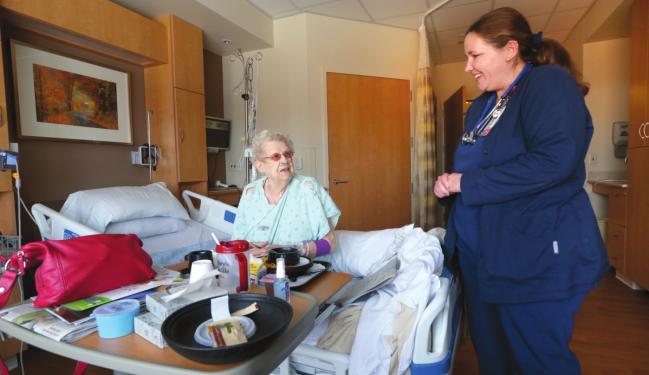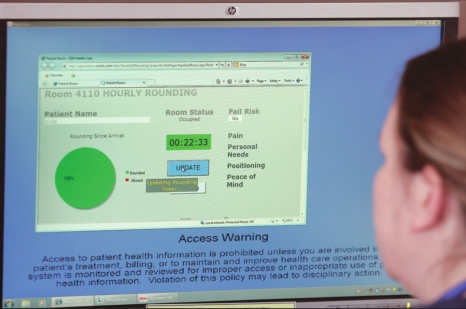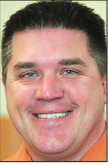
Patient-care tracking system developed at St. Mary’s Janesville Hospital spreads to other Midwest hospitals
JANESVILLE
The idea seemed simple enough. Find an easy way for nurses to make sure they’re checking in regularly with patients.
But when St. Mary’s Janesville Hospital looked into tossing the paper checklist for an electronic system, the only one on the market cost $500,000.
The nursing staff focuses on “purposeful rounding,” checking on several Ps—pain, position, personal needs and piece of mind—among other things during the hourly checks, said Crystal Campton, medical/surgical registered nurse.
“It keeps us in the patient room, so that decreases the amount of call lights we have,” she said. “Us being in there really ensures the patients’ safety, their comfort. We are able to anticipate their needs.”
Staff kept track of rounding in the hospital’s 50 rooms using paper until hospital technology and system managers developed an electronic program in Janesville. It is now going live in hospitals around the Midwest and could find its way into thousands—or millions—of hospital rooms across the country.
How it works
Computer screens in the team room and patient rooms show how long it’s been since each patient’s hourly round. If the nurse and patient are highlighted in green, it’s been less than 50 minutes. After 50 minutes, the entry turns yellow, and the assigned nurse and nursing assistant receive a text-message reminder to visit the assigned room in 10 minutes. The message also says, “Remember hand hygiene.”
If the nurse-patient combination hits an hour between visits, the entry on the screen turns red, and another text message is sent at 70 minutes.
When the nurse completes her visit, she hits the “update” button on the screen in the patient’s room to reset the clock.
Caregivers are able to see who needs help with his or her workload at a quick glance. The system, called “Go Green,” shows patients and staff the percentage of time in the past 24 hours that the nursing team met its goal of rounding every hour.
Go Green was implemented at St. Mary’s Janesville Hospital for about $1,000 in equipment.
 The task
The task
St. Mary’s Janesville Hospital is a part of St. Louis-based SSM Health Care, which, “as an organization, says that patients and customers are our first priority,” said Christian Ray, system manager, improvement and innovation for SSM Health Care.
“We
wanted to create an exceptional patient experience from day one. When
we opened the hospital, we realized that this is a lot harder to manage
than what it was when this was just a concept,” he said.
The hospital opened in January 2012.
Hospital
President Kerry Swanson gave staff the objective to hard-wire rounding
for every patient and be able to track it every time by September 2012,
Ray said.
“We knew we couldn’t do what everybody else does,” he said. “We had to completely re-engineer the process.”
They
asked nurses what they needed to have high reliability in rounding, and
the answer was a one-step process, said Ray, who has a manufacturing
background and worked at General Motors in Janesville.
“One
of the nurses said to me, ‘Let me take your iPhone away from you, and
let me see how many meetings you make it to during the day,’” he said.
“So that told us they need help with the management of the process, and
that’s what we tried to provide in a one-step process.”
Every nurse and nursing assistant already carried an Ascom wireless hospital phone for calls and text messages.
 Ray
and Jake Verbeten, information systems manager at the hospital, worked
together using standard computer software— Microsoft Excel and Microsoft
Outlook—to send messages to the Ascom phones.
Ray
and Jake Verbeten, information systems manager at the hospital, worked
together using standard computer software— Microsoft Excel and Microsoft
Outlook—to send messages to the Ascom phones.
“We just kind of assembled pieces together to make it all work,” said Verbeten, who served 18 years in the military.
In August 2012, a prototype
went live on the hospital’s third floor, which has surgical, orthopedic
and pediatric patients. Verbeten and Ray demonstrated the process to
the administrative team and Swanson, who saw the potential for not only
the hospital and SSM system but to the industry, Ray said.
“This is value our industry doesn’t have,” he said.
They took their idea to SSM’s innovation conference, where it took off.
“When
we showed the nurses what we were doing, they went wild to have this in
their location,” Ray said. “That excitement sparked resources to be
allocated to a more-refined process.”
An
SSM team of developers in St. Louis took over to scale Go Green. The
web-based program now uses Microsoft SharePoint. Since May 2013, Go Green
has gone live at three other SSM hospitals.
“Hopefully,
by the end of this year, we have it throughout the entire system, which
would be 4,000 patient rooms,” Ray said. “Right now, it’s on about 600
patient rooms.”
Patient satisfaction
“The
nice thing about this is it takes away the focus on just increasing
patient satisfaction,” Ray said. “If I want to increase patient
satisfaction, I’m not going to just go increase it or just hope that it
increases. This is driving a behavior that we want to create a habit out
of, and it’s something that the nurses can take ownership in.”
 Joaquin
Monjarez of Janesville spent a week in the hospital for addiction
treatment in January. He praised the staff members, who were there for
him around the clock, he said.
Joaquin
Monjarez of Janesville spent a week in the hospital for addiction
treatment in January. He praised the staff members, who were there for
him around the clock, he said.
Everyone
from nurses and doctors to housekeeping and cafeteria staff treated him
professionally and with dignity, he said. He rarely had to hit the call
button, he said, “but when I did, they were there.”
“That just amazed me how they all worked as one unit,” he said.
The focus is on purposeful rounding,
so nurses are using the time with the patient valuably, said Kathi
Glenn, director of medical/surgical and intensive care unit. She has
managed intensive care units and telemetry units elsewhere and sees how
the technology here gives the nursing staff the tools that work for
them.
“It was very
difficult at times to get nurses to be compliant to a piece of paper
because a piece of paper meant very little to them,” she said.
Feedback
from patients during rounding with nurses and team leaders, along with
patient surveys, shows the effort is paying off, she said.
The
government’s Hospital Consumer Assessment of Healthcare Providers and
Systems, or patient satisfaction survey, collects data from patients
nationwide about their recent hospital stays. St. Mary’s Janesville
Hospital has seen its numbers increase as nurses started using Go Green,
Ray said.
From the
eight months between its opening and August 2012, the hospital was in
the 72nd percentile for how likely patients would be to recommend the
hospital, he said.
The hospital is in the 92nd percentile from August 2012 through February.
“This
is really about engagement—engaging the staff, helping them to build
that trusting relationship, connecting with their patients and families,
and now they’re showing proof. I can measure that,” Glenn said. “When
you have all that green up there (on the screen), I’m building great
relationships with patients and families because I’m in my room all the
time.”
Verbeten ended
up in the hospital last year as a patient for two nights. He had pain
issues during his stay, but with the constant attention, he said he
didn’t have to worry about pushing the nurse-call button.
“I knew … a nurse is going to be back here in five minutes,” he said. “That really was a nice comfort for me.”
It also was fun to watch nurses use the system he helped create, he said.
“I could definitely see the advantage of being seen hourly,” he said.
The newness of the hospital contributed to the innovation, Verbeten said.
“This hospital hasn’t established a set of habits,” he said, so staff members are “much more willing” to try new things.
“Technology
opens the door for process control,” Ray said. “The conversion to
technology by itself is not an innovation. It what do you do now that
it’s on this platform?” “The biggest outcome from this is we learned
that we can innovate, that we can make a difference.”